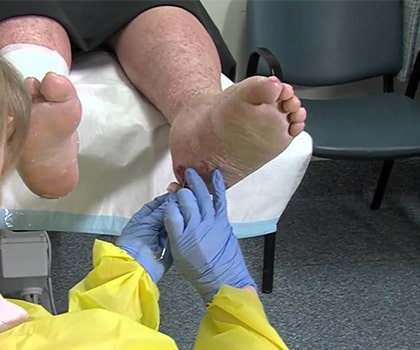A Renowned Vascular Clinic for Diabetic PAD Stenting
Peripheral Arterial Disease (PAD), also known as Peripheral Vascular Disease (PVD), which is a very common condition affecting people age 65 and older. PAD occurs when the Cholesterol and the scar tissue is built up by forming a substance, Plaque, inside the arteries. PAD is a serious condition that is developed as a result of the hardening of the arteries or Atherosclerosis.
Diabetic PAD Stenting is the best procedure for Diabetic Foot Vascular Surgery followed by our Vascular Interventions.

The clogged arteries cause faded blood flow to the legs, which may lead to pain while walking and eventually gangrene and amputation.
Because atherosclerosis is a systemic disease (that is, affects the body as a whole), individuals with PAD are liable to have blocked arteries in other areas of the body. Thus, those with PAD are at increased possibility for heart disease, aortic aneurysms, and stroke. PAD is also a sign of diabetes, hypertension, and other conditions.
PAD may also be caused by blood clots.
The most general symptom of PAD is called intermittent claudication, which is a painful cramp in the leg or hip that occurs while walking or exercising and typically disappears when the person stops the activity.
- Numbness, tingling, and weakness in the lower legs and feet
- Burning or aching pain in feet or toes whilst resting
- Sore on leg or foot that won’t heal
- Cold legs or feet
- Color change in the skin of legs or feet
- Loss of hair on legs
- Having pain in the legs or feet that awakens you at night
- Many people simply live with their pain, assuming that it is a normal part of aging, rather than reporting it to their doctor.
Angioplasty and Stenting:
Interventional radiologists pioneered Diabetic Foot Vascular Surgery, angioplasty, and stenting, which was first conducted to treat peripheral arterial disease. Using imaging for assistance, the interventional radiologist threads a catheter through the femoral artery in the groin, to the blocked artery in the legs. Then the interventional radiologist inflates a balloon to open the blood vessel wherever it is narrowed or blocked. In a few cases, this is then held open with a stent. This is a minimally invasive treatment that does not require surgery, just a nick in the skin the size of a pencil tip. For the treatment of PAD, Balloon Angioplasty and Stenting has stood as a first-line treatment by replacing Invasive Surgery.
Atherectomy:
In this type of treatment, the substance, Plaque, which is formed inside the artery is shaved or removed through inserting the tiny catheter into the artery where the blockage has occurred.
Stent-grafts:
A stent that is covered with synthetic fabric is inserted into the blood vessels to outflank the diseased arteries.
The treatment period depends on the age group and how they respond to the treatment.
Q: How is PAD-related to diabetics?
A: Fatty deposits build up in the inner linings of the artery walls of the legs, making them narrower, hinder the blood flow, and can even stop blood flow to the legs and feet completely.
